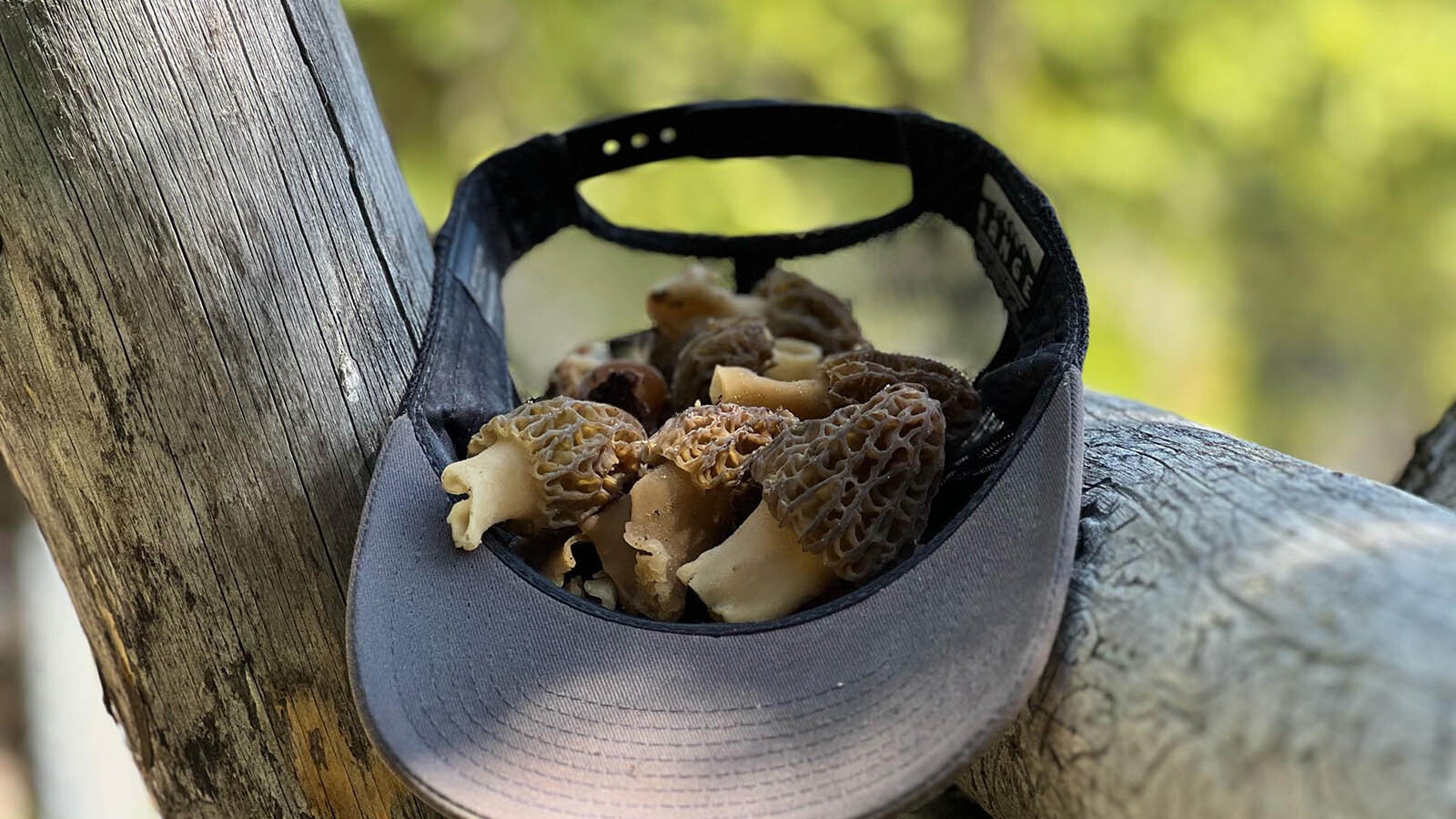Foragers who will soon be hunting for those tasty morel mushrooms hiding under cottonwood trees or alongside lady slipper orchids in Wyoming could be in for a pleasant surprise this year, if prices in Ohio are any indication.
A consumer there posted a photo of morel mushrooms from a grocery store priced at $75 a pound. That’s a lot more than their more usual $50 to $65 per pound prices, according to a Wyoming mushroom hunter in the Riverton area.
“The last few years, the high point’s been at $50,” Daniel Stewart told Cowboy State Daily. “To see it now, upward of $75, that’s just kind of remarkable, honestly.”
But it didn’t surprise Stewart to see prices explode like that, particularly right now.
Morel season is just starting to take off in Southern states, and the season is opening against a backdrop he describes as a “shroom boom.” Americans are clamoring for all things mushroom, with scientific studies recently highlighting their many health benefits.
The highest prices for morels often come at the beginning of the season when people are just like “grizzly bears coming out of hibernation” and want their morel mushrooms right now, Stewart said.
“They just taste so good,” Stewart said when asked why people are willing to pay such high prices for something that essentially grows from decaying matter. “And the season is so short and unpredictable year to year.”
Morels also have a pleasing texture, Lander mushroom expert Jack States told Cowboy State Daily.
“Morels are one of the few fungi that have a firm texture when cooked (not mushy),” he told Cowboy State Daily in an email. “And they contain a chemical compound that tickles the taste buds, similar to monosodium glutamate, MSG, a flavor enhancer.”
These are factors that have high-end restaurants seeking out morels during their short season — and willing to pay extra high prices for them.
States added that the season right now is young, and that he was told by North American authority on mushroom markets, Daniel Winkler, that they’ll likely go down as the season progresses and supply rises.
Things To Know About Morels
Morels are one of the easiest of the wild mushrooms to hunt, Stewart told Cowboy State Daily.
“Especially under cottonwoods, there’s really nothing else you’re going to find that looks like them,” he said. “But people should still make sure they know what they’re identifying and should definitely not trust the apps that are out there. I’ve seen apps that are right now identifying strands of hair as mushrooms. They’re so bad.”
Morels have a characteristic honeycomb pattern on their caps and are typically a golden color, but they can sometimes be tan or gray.
False morels, which appear similar but have toxins that cannot be cooked away, tend to be more red, purple or brown.
The best diagnostic, though, is to cut the mushroom in half. True morels will be hollow, while false morels have cotton-like fibers and tissues throughout.
That’s led to a little folklore adage — if it’s not hollow, do not swallow.
“The lookalikes will make you sick even if you cook them well, but probably won’t kill you,” Stewart said. “You’re gonna have a stomachache and, you know, gastro problems with diarrhea and stuff like that.”
But all mushrooms, even morels, should be well-cooked, Stewart added.
Even morels have some toxins that can be unpleasant if not thoroughly cooked. In fact, morels were linked to an outbreak of illness last year in Montana that led to three hospitalizations and two deaths, as well as about 50 others who reported nausea and upset stomachs.
The Centers for Disease Control and Prevention has determined the outbreak was linked to consuming raw morel mushrooms at a sushi restaurant in Bozeman.
Finding Morels
Morels only begin to appear when nighttime temperatures are no longer below freezing, Stewart said.
“The kind of general rule that works really well is once you start seeing big dandelion blooms in the yard and blossoms on the lilac trees, that’s the time to start looking for them,” he said. “So around here, I usually start looking around river bottoms about the middle to end of May.”
As the season progresses and the temperatures get too warm for morels, Stewart will start heading up into the mountains, sticking with elevations at the same temperature range that morels love.
“So, looking on the edge of the snowbanks as it melts up in the mountains under spruce trees, and then the morels will change, too,” he said. “You’ll get one type down here, and then you’ll get another variety up in the mountains.”
Blond morels tend to like sandy soil, Stewart said, and will partner with semi-hardwood trees like willows, cottonwoods and poplars.
“I’m pretty excited because things are warming up, and we’re getting some good moisture,” Stewart said.
That means morel hunting season will soon be here, an event that feels like Easter for adults for mushroom enthusiasts like Stewart.
Hard To Commercialize
Even with such attractive prices, though, Stewart isn’t interested in bringing morels to high-end restaurants.
“I’ve never come across a yield large enough to consider taking it in to market or to chefs,” he said. “For me, it’s more about publicity and education and pictures. I just love taking mushroom pictures.”
One place those hoping to find large volumes of the mushrooms might try are wildfire areas, Stewart suggested.
“The yields there can be outstanding,” Stewart said. “And so that’s one thing a lot of people will do, is hunt last year’s wildfire areas.”
Morels are also generally too difficult to grow, Austin Webster, a mushroom grower in Evanston, told Cowboy State Daily.
“I do not hunt for them,” he added. “There’s too many rules and regulations with the USDA to get licensing (to sell) morels.”
One reason morels are hard to grow is the partial symbiotic relationship to hardwoods, States said.
Despite that, some private and commercial mushroom growers are finding ways to grow them in climate-controlled greenhouses that produce year-round, States added.
“But even that methodology often fails to produce a consistent commercial product,” States said. “As for me, I’ve remained a career mycologist and avoided getting into culturing fungi. I know how to grow them, but prefer to roam the Rocky Mountain forests looking for new species.”

Even More Expensive Than Morels
Those trying to make high profit off wild mushrooms, though, might be barking up the wrong tree with morels. That’s because they’re actually not the most expensive mushroom foragers can find in North America.
That distinction goes to the American matsutake and, particularly when it’s exported to Asian chefs who consider it more of a delicacy than perhaps American chefs do, it can go for some pretty high figures.
“Those can go upward of $400 a pound,” Stewart told Cowboy State Daily. “Matsutake is probably the most fragrant mushroom out there that you can eat. When you break it open, it smells like cinnamon, red hots and earth.”
That smell carries through in the cooking, too, Stewart added.
“So, we would do dishes like orange chicken and then have this sort of spicy mushroom in it,” Stewart said. “And it would be very delicious.”
Stewart has found matsutakes in Idaho, but has yet to find them in Wyoming, though he’s been told they’ll grow here, too.
Given their habitat near jack pine and lodgepole pines, he thinks they probably do grow here, but maybe only at specific elevations.
“They just love pine,” Stewart said. “And we found them in lots of stands in northern Idaho. So, it wouldn’t really surprise me to find them here and I constantly do look for them.”
Another fairly expensive mushroom that could grow wild in Wyoming, but would be even more elusive than either morels or matsutake, would be cordyceps — the same mushroom blamed for turning humanity into zombies in the sci-fi thriller set in Jackson Hole, “Last of Us.”
“You’re going to find that one mostly farmed,” Stewart said. “It’s too hard to gather a lot of it wild, because you’re looking for a bug that wandered off and died and this little orange cone grew from it.”
The cone is generally only going to be about an inch tall as well, making it difficult to spot.
The most expensive cordyceps of all is native up in the Himalayan mountains and sells for between $20,000 to $50,000 per pound.
That particular mushroom is generally not hunted wild. It’s grown by infecting caterpillars.
Renée Jean can be reached at renee@cowboystatedaily.com.











